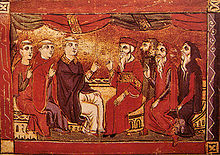ʿIsa Tarsah Kelemechi[1] (simplified Chinese: 爱薛; pinyin: Àixuē, fl. 1248–1312) was a Church of the East astronomer and physician[2] at the Yuan court of Kublai Khan's Mongol Empire in the 13th century.

Astrologer in China
editʿIsa was named head of the Office of Western Astronomy established by Kublai Khan in 1263 to study Islamic astronomical observations.[3] Kubilai would establish a Observatory for Islamic astronomy in 1271, directed by astronomer Jamal ad-Din Bukhari.[3]
ʿIsa was also instrumental in reinforcing anti-Muslim prohibitions in the Mongol realms, such as prohibiting halal slaughter and circumcision, and, according to Rashid-al-Din Hamadani encouraged denunciation of Muslims.[4] ʿIsa also showed to Khubilai the Sword Verse of the Quran, raising the suspicion of the Mongols towards Muslims.[4] According to Rashid al-Din, as a result, "most Muslims left Khitai [China]".[4]
Diplomat to Europe
editIsa Kelemechi was later a member of the first mission to Europe sent by Arghun, the Il-Khan in 1285. He met with Pope Honorius IV, remitting a letter from Ghazan offering to "remove" the Saracenz and divide "the land of Sham, namely Egypt" with the Franks.[5][6] The message, written in imperfect Latin, said:
"And now let it be [says the Il-Khan], because the land of the Saracens is not ours, between us, good father, us who are on this side and you who are on your side; the land of Scami [Sham] to wit the land of Egypt between you and us we will crush. We send you the said messengers and [ask] you to send an expedition and army to the land of Egypt, and it shall be now that we from this side shall crush it between us with good men; and that you send us by a good man where you wish the aforesaid done. The Saracens from the midst of us we shall lift and the Lord Pope and the Cam [Great Khan Qubilai] will be lords".
— Message from Arghun to Pope Honorius IV.[6]
The 1285 embassy would be followed in 1287 by that of Rabban bar Sauma.[5]
See also
editNotes
edit- ^ Foltz, Richard, Religions of the Silk Road, Palgrave Macmillan, 2nd edition, 2010 ISBN 978-0-230-62125-1, pp. 125–126
- ^ Atwood, Christopher Pratt (2004). Encyclopedia of Mongolia and the Mongol Empire. Facts On File. p. 107. ISBN 978-0-8160-4671-3.
- ^ a b Thomas F. Glick; Steven John Livesey; Faith Wallis (2005). Medieval science, technology, and medicine: an encyclopedia p.485. Routledge. ISBN 0-415-96930-1.
- ^ a b c Richard Foltz (2000). Religions of the Silk Road: Overland Trade and Cultural Exchange p.125ff. Palgrave Macmillan. ISBN 0-312-23338-8.
- ^ a b Peter Jackson (2005). The Mongols and the West, 1221-1410 p.169. Pearson Education. ISBN 0-582-36896-0.
- ^ a b William Bayne Fisher; John Andrew Boyle (1968). The Cambridge history of Iran p.370. Cambridge University Press. ISBN 0-521-06936-X.